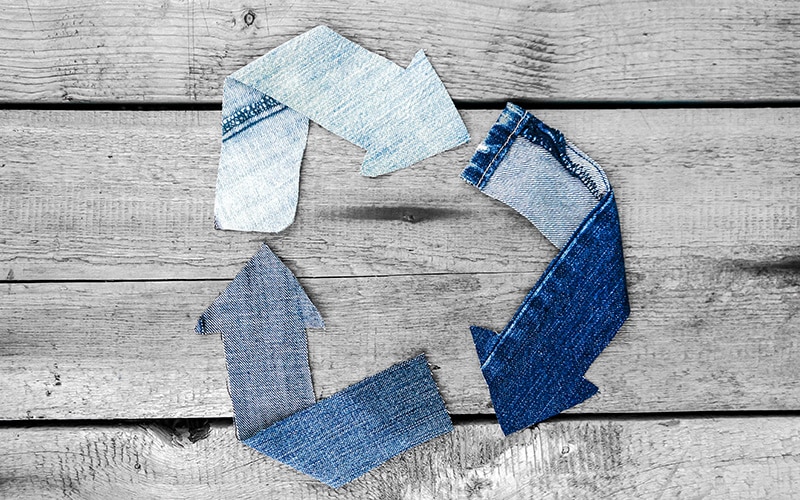Concerns about the growing volume of discarded textiles heading to landfills has made textile recycling a new focus for governments, environmental groups and individuals focused on sustainability.
Retailers, state and local governments, charitable organizations, and third-party recycling programs are all ramping up efforts to collect, re-use and recycle discarded items made from fabric.
In the United States, post-consumer textiles are one of the fastest growing waste streams. Textiles include any fabric item such as clothing, towels, bedding, curtains, and goods such as footwear, handbags, belts, and mattresses. The average person tosses out about 70 pounds of textiles each year, according to the Center for Textile Recycling, and of that, about 15 percent is reused or recycled. The rest is landfilled or incinerated when, in fact, it could be reused or recycled with many social, environmental, and economic benefits.
The benefits of textile recycling
Keeping textiles out of the waste stream provides significant societal benefits.
Environmental:
- Decreases the valuable materials going into landfills. This saves landfill space and cuts down on the waste of resources.
- Cuts back on the need for new textiles which saves natural resources including water and petroleum.
- Reduces toxins from pesticides, herbicides, dyes, and other chemicals used in textile production. Cotton, for instance, is the crop requiring the greatest pesticide use in the world today.
Economic:
- Allows valuable material to remain in the supply chain as a component of new products. Using shredded fibers for building insulation is one example.
- Reduces disposal costs for local governments if used textiles are kept out of the trash.
Social:
- Provides clothing and household supplies to people in need.
- Creates interesting and unique art and consumer goods through the upcycling of textiles.
Given the growing problem of textile waste and the tangible benefits of keeping textiles out of the waste stream, the state of Massachusetts last year banned the disposal of textiles and mattresses. The state Department of Environmental Protection website instructs residents to use the “Beyond the Bin” online recycling directory to locate recycling options near them. The department also lists numerous manufacturer and retailer take-back programs that state residents can use. Similarly, European Union member countries are setting up textile recycling infrastructure with the goal of implementing a textile recycling system in 2025, according to Recycling Product News.
Challenges of textile recycling
Despite the benefits of textile recycling, it is not without its challenges. One problem is that, frequently, textiles donated by people through various organizations are ultimately shipped to developing countries where they are left to accumulate in piles. Without the infrastructure or technology in place, letting mountains of textiles pile up on beaches and in deserts does not achieve the environmental or supply chain benefits sought with textile recycling.
Another challenge is the textiles themselves. Today’s fabrics are often blended from different materials, like a cotton and polyester blend for example. It is difficult to separate and process these different fibers, and different methods may be needed to recycle them. For this reason, most textile recycling is not “fiber to fiber,” but is instead downcycled, allowing shredded fibers to become something like rags or carpet padding. An additional complication is the existence of hardware like zippers, buttons and other fasteners which must be removed before fiber shredding or separation can begin.
Compared to other materials like scrap metal, glass, and plastic, the collection, sorting and processing of textiles is limited and in its very early stages. It is not yet available in some areas. While progress has been made in textile recycling, according to industry reports, the technology is not yet ready to be implemented on a large scale. Industry experts are calling for more research, development, and investment to scale up the processing of discarded textiles and allow for more fiber-to-fiber recycling.
How to keep used textiles out of the waste stream
It is estimated that 95 percent of all used clothing, footwear and cloth household products like sheets, towels, and curtains, can be recycled even if they are stained, ripped, torn, or missing buttons and zippers. Any textile item can be recycled, according to recycling websites, as long as it is not wet, moldy, or stained with blood, grease, oil or solvents.
For the first step, clothing or other household textiles that are in good shape can be reused by others if donated to charity or brought to a thrift store for resale. Items that are not in good enough shape to be re-used can be recycled using some of the following methods.
- Many counties and other municipalities now have drop off centers for textiles. An internet search of “textile recycling near me” will usually result in some options. Check the website of the government department that handles your recycling. Most often they will show which drop off centers have bins for textile recycling.
- Use a take-back program. These new programs allow consumers to send them bags of discarded textiles to keep them out of landfills. These organizations collaborate with a network of recycling partners to divert textiles from the waste stream. One such company, ReTold Recycling, sells large bags on its website that individuals fill and mail back to the company, confident that the contents will be handled in a sustainable way. ForDays, an online retailer of sustainable products, has a similar take-back program in which customers can buy a take-back bag online, fill it with any textiles and mail it back to ForDays for recycling. Although consumers must pay for the bags up front, often these programs will then issue customers credits for future purchases from their website to compensate for the cost.
- Take items to a retail partner. More clothing chains and manufacturers now will accept donations of used textiles from any brand. Companies like H&M and the North Face allow clothing donation drop offs in their stores, according to their websites. At the Levi Strauss website, you can download a pre-paid shipping label and mail the company discarded textiles, and the retailer Madewell accepts donations of jeans from any other manufacturer. All of these retailers will issue credits or discounts for your donation that you can use for future purchases. An internet search will find additional stores that reward customers who bring or ship clothing donations to their locations.
About ScrapWare Corporation: Since 1989, Rockville, Maryland-based ScrapWare Corporation has been the software of choice for the recycling industry. Its ease of installation and simplicity saves users time and money while helping them achieve compliance and maintain accurate business insights. With state-of-the-art functionality that‘s tailored to each organization’s unique requirements, ScrapWare is an advanced dynamic software solution that alleviates the most pressing recycling industry worries. For more information, please call (301) 517-8500 or visit https://www.scrapware.com/.

